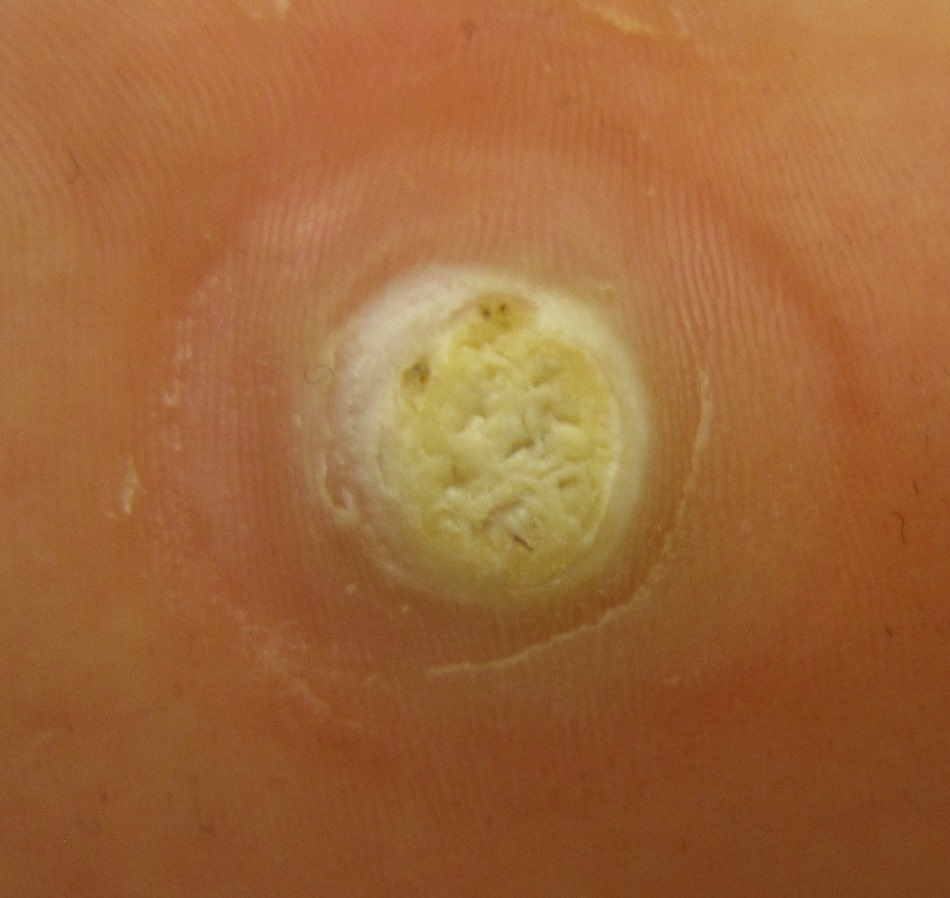What are the symptoms of plantar warts?
Plantar warts are small, benign growths that occur on the soles of the feet due to infection with the human papillomavirus (HPV). The symptoms can vary, but common signs include:
- Hard, grainy growths: Typically found on the weight-bearing areas of the foot, such as the heels or balls of the feet.
- Calloused skin: The wart may develop a thick, hardened layer of skin (callus) on top, which can be mistaken for other foot conditions.
- Pain or tenderness: The wart may cause discomfort, especially when pressure is applied while walking or standing.
- Black dots: Small black specks, which are tiny blood vessels, may be visible within the wart, giving it a distinctive appearance.
- Rough texture: The surface of a plantar wart can be rough or bumpy, differing from the smooth texture of the surrounding skin.
- Location: They typically appear on the soles of the feet, but can also develop on the toes or sides of the feet.
- Multiple growths: Some individuals may develop more than one plantar wart at a time.
Symptoms can vary in intensity, and some individuals may experience little to no discomfort, while others may find plantar warts quite painful.
What are the causes of plantar warts?
Plantar warts are caused by an infection with the human papillomavirus (HPV). Here are the key factors contributing to their development:
- Human Papillomavirus (HPV): Several strains of HPV can cause plantar warts. The virus enters the body through tiny cuts, cracks, or weakened areas on the skin of the feet.
- Direct contact: Plantar warts are contagious and can spread through direct contact with infected surfaces, such as:
- Public swimming pools
- Locker rooms
- Showers
- Shared footwear or towels
- Weakened immune system: Individuals with compromised immune systems may be more susceptible to HPV infections and may experience more frequent or severe warts.
- Moist environments: HPV thrives in warm, moist environments, making areas like swimming pools and locker rooms prime locations for transmission.
- Skin trauma: Minor injuries or damage to the skin on the feet can facilitate the entry of the virus, increasing the likelihood of developing plantar warts.
- Age: Plantar warts are more common in children and adolescents, but they can occur at any age. The immune response to HPV may be less effective in younger individuals, making them more susceptible.
Understanding these causes can help in prevention and management strategies for those at risk of developing plantar warts.
What is the treatment for plantar warts?
Treatment for plantar warts focuses on removing the wart and alleviating any associated discomfort. Options may include:
- Over-the-counter treatments:
- Salicylic acid: Available in various forms (liquids, gels, pads), this medication helps to gradually peel away the wart by softening the skin.
- Cryotherapy products: Some over-the-counter freezing products can be used to freeze and destroy the wart tissue.
- Cryotherapy: Performed by a healthcare provider, this involves freezing the wart with liquid nitrogen. This treatment usually requires multiple sessions and can be effective in destroying the wart.
- Electrosurgery: This technique uses an electric current to burn off the wart. It may be combined with curettage, where the wart is scraped away after burning.
- Laser therapy: A focused beam of light is used to destroy the wart tissue. This method is typically reserved for resistant cases.
- Immunotherapy: This approach aims to boost the immune system’s response to the virus. It may involve topical treatments that stimulate an immune reaction or injections of immune-modulating agents.
- Surgical removal: In some cases, especially for warts that do not respond to other treatments, surgical excision may be necessary to completely remove the wart.
- Home remedies: While not clinically proven, some individuals find relief using duct tape to cover the wart, which may help suffocate the wart and promote shedding of the affected skin.
- Preventive measures: To reduce the risk of recurrence, it’s important to practice good foot hygiene, avoid walking barefoot in public areas, and refrain from picking at warts.
Consulting a healthcare professional is advisable for a proper diagnosis and to determine the most appropriate treatment based on individual circumstances.

Leave a Reply
You must be logged in to post a comment.